This year’s Titchwell Manor Tour started on Tuesday night, with a short meeting to discuss the plans for the next two days followed by a delicious dinner in the award winning restaurant at the hotel. The following morning, we met at 8.30am for a full day’s birding in the field. The weather was not at its most accommodating. We were forecast showers – we ended up getting light rain and mist most of the day. As usual, it didn’t stop us getting out and seeing some very good birds.
We headed east along the coast to Holkham first. We stopped half way along Lady Anne’s Drive to admire a flock of Pink-footed Geese feeding on the grazing marshes. There were several hundred on either side of the road today – but many more had probably roosted here and flown inland to feed at first light. It was nice to get a good look at them through the scope. Helpfully, a couple of Greylag Geese were even in the same view to compare at one point.
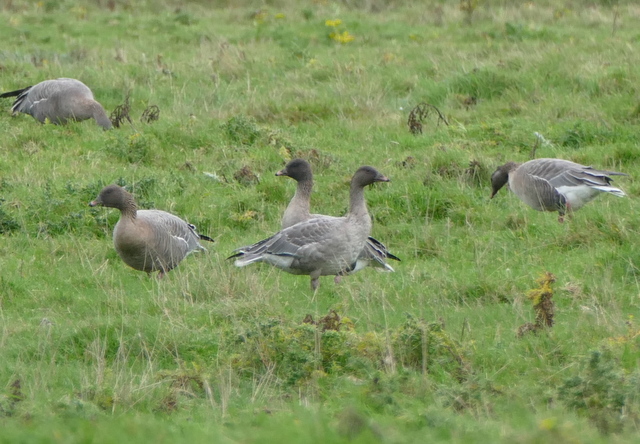 Pink-footed Geese – along Lady Anne’s Drive this morning
Pink-footed Geese – along Lady Anne’s Drive this morning
While we were watching them, two Fieldfare flew over calling and dropped down onto the grass. Thrushes and Blackbirds are continuing to trickle in over the North Sea from Scandinavia for the winter.
There was light rain falling as we walked west on the inland side of the pines. We heard the odd Goldcrest calling, but otherwise the trees were rather quiet today. The tit flocks often seem to retreat deeper into the pines when the weather is inclement. We stopped at Salts Hole to admire a flock of Wigeon which had dropped in to bathe, the drakes now looking very smart as they finish emerging from eclipse plumage. As usual, there were several Little Grebes on here as well today.
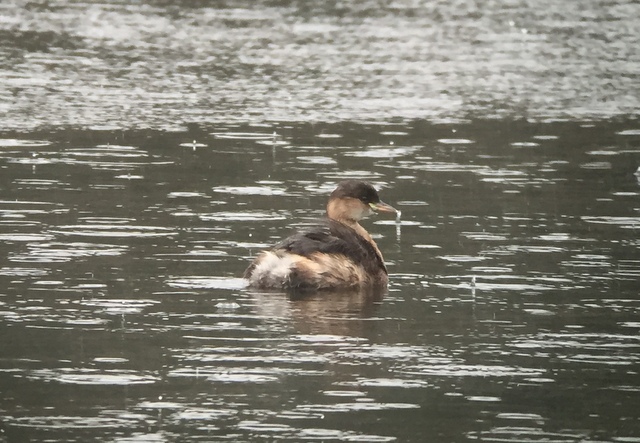 Little Grebe – at least 5 on Salts Hole today
Little Grebe – at least 5 on Salts Hole today
It was hard to see right across the grazing marshes this morning because of the mist. However, a white shape in a distant tree stood out even through the gloom. It was a very pale Common Buzzard, with almost completely white underparts. It flew down onto the grass and we got the scope on it. Well known to us, it is often in the trees here. Common Buzzards are variable in appearance and very pale birds are increasingly common, creating a pitfall for the unwary.
The rain started to fall harder, so we sought the shelter of Washington Hide only a little further along the path. There were several ducks on the pool below the hide, including several Shoveler and Shelduck. The drake Shoveler is rather similarly coloured to Shelduck, so it was good to have an opportunity to compare the two. A Marsh Harrier was perched in the top of one of the bushes, getting wet. For a while it stood with its wings outstretched, presumably trying to shake off the water. A second Marsh Harrier appeared nearby and began to do the same.
It was while we were watching the Marsh Harriers that a large white shape suddenly flew in towards us and started to drop down towards the pool below. This Great White Egret has been hanging around at Holkham for over two months now, but it is not always in view and spends lots of its time out in the ditches, so it was nice to catch up with it today. It did a nice circuit walking round the pool for us – we could see just how big it was and admire its long dagger-shaped yellow bill.
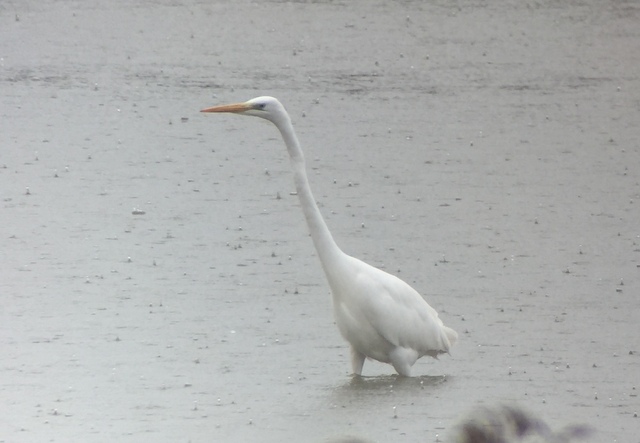 Great White Egret – dropped in to the pool in front of Washington Hide
Great White Egret – dropped in to the pool in front of Washington Hide
After a short while, the rain eased a bit, so we set off again to walk a little further west. The view from the Joe Jordan Hide seemed rather quiet at first. Carefully scanning the fields, we spotted the head of a small dark goose appear from the grass and, as it turned to face us, we could see it had a distinctive white surround to the base of its bill. There is normally a small flock of White-fronted Geese at Holkham through the winter, visitors here from their breeding grounds in Russia, but this was the first returning one we had seen this autumn. As we watched, we could see that there was actually a small family party of White-fronted Geese, two adults followed by 3 juveniles.
When the skies started to brighten up a fraction, that seemed to be the cue for several raptors to appear, as if by magic. A Sparrowhawk flew up into the tops of the trees in front of the hide briefly, an adult male with slate grey upperparts and orange-barred underparts. The scaffold tower had been devoid of life since we had arrived in the hide, but scanning again and an adult Peregrine had appeared on the top of it, presumably coming out to try to dry itself off.
The rain seemed to have eased as well, so we decided to start making our way back. There were a few more birds about along the path now. We stopped to listen to a couple of Goldcrests and heard our first tit flock of the morning approaching. There were several Long-tailed Tits calling but at first they flew past us through the very tops of the pines. We watched as they moved ahead of us and saw the flock drop down into the bushes near Meals House. We walked back quickly and could see Long-tailed Tits in the birches first, quickly joined by a few Goldcrests. Then we picked up first one then two Chiffchaffs in amongst them. The flock was moving quickly all the time, and as fast as they had arrived they disappeared back in the direction they had just come.
The other side of Meals House, almost back to Washington Hide, we heard more Long-tailed Tits calling and stopped to watch a small flock drop down to feed in a small sycamore by the path. Suddenly a Yellow-browed Warbler appeared in the same tree, a real bonus. Breeding in Siberia and migrating down to Asia for the winter, they are an increasingly regular visitor here mainly in Autumn, but always a great bird to see. It flicked about among the branches for a few seconds, easier to see now that there are much fewer leaves left on the trees. We could see its bright supercilium and double wing bars. This flock was not hanging around either and quickly moved off along the path towards Washington Hide. We walked back that way, but couldn’t find the Yellow-browed Warbler with the tits again.
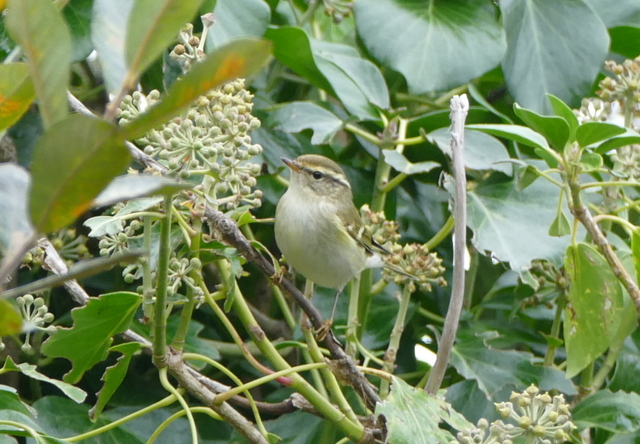 Yellow-browed Warbler – here’s one from a couple of weeks ago
Yellow-browed Warbler – here’s one from a couple of weeks ago
We decided to have a quick look at the beach, so walked along to the end of the boardwalk. There were only a few people on the beach today, and a single horse rider. Scanning the edge of the sea beyond the sand, we picked up a moulting Red-throated Diver just offshore. A single Gannet flew past, just on the edge of the mist. Further along, we found a Slavonian Grebe on the sea, another nice surprise. Unfortunately it was a little distant and, being so small, it was hard to see at times among the waves. We might otherwise have been tempted to walk out for a better look, but it started raining again at that point and it was already getting on to lunch time, so we decided against it.
As we made our way back along boardwalk, the tits had appeared in the sycamores again. There was no sign of the Yellow-browed Warbler at first, but then it flew across the clearing into the pines on the other side, before quickly disappearing into the trees.
We stopped for lunch in Wells, then walked out to have a look at the harbour. Despite the tide being just past high, there were lots of birds along the shoreline. In particular, there was a fantastic selection of waders. Scanning through the throng, we could see lots of Oystercatcher, several Ringed Plover, a few each of both Grey and Golden Plover, a good number of dumpy Knot and several small flocks of silvery grey Sanderling, with a smattering of browner Dunlin in amongst them, lots of Curlew and Redshank and singles each of Bar-tailed Godwit and Turnstone. Not a bad haul! There were also plenty of Brent Geese feeding out on the mud.
 Brent Geese – there were many feeding on the mud by the harbour
Brent Geese – there were many feeding on the mud by the harbour
As we had been scanning harbour, the mist started to descend again. As it did so, despite it being over two hours to sunset, the light started to fade rapidly. Our hope had been to catch some raptors coming in to roost to finish the day, but now it looked like we would need to hurry if we were to catch them. We bid farewell to the harbour and made our way further east along the coast to Stiffkey.
By the time we got there it was raining again. Visibility was so poor we couldn’t even see the trees on East Hills, it seemed like we might be out of luck. There were lots of Little Egrets, Brent Geese and Curlews. A lone Greenshank was feeding quietly in one of the deeper channels – more common here as a passage migrant, a few do stay right through the winter out on the saltmarshes. We also heard Rock Pipits calling overhead.
Then a positive sign as a Marsh Harrier flew west across the marshes in front of us – perhaps we might still see some raptors come in to roost. A Short-eared Owl also appeared briefly, perched up on the top of a bush. It sat there for a while, then dropped down again out of view as the rain picked up once more. Again, it felt like we might be out of luck and we walked back to the car to take shelter.
As we stood there watching, finally the weather brightened up a little. The rain stopped and the mist lifted, and there was even a little patch of clear sky which appeared above us. We heard Mistle Thrushes calling, and one flew into the top of fir tree in front of us; a single Redwing flew overhead; a Song Thrush darted across the car park and dived into the hedge.
As the mist lifted, we scanned the marshes to the west again and over towards East Hills, which had emerged from the clouds. Almost immediately we picked up a ringtail Hen Harrier. It flew back and forth for a while, chased by a Carrion Crow. Smaller and slimmer than a Marsh Harrier, we could see the distinctive square white patch at the base of the tail through the scope.
We thought that might be the best of it given the weather this evening and were just thinking about leaving when the bird we had been hoping to see appeared. A stunning silvery-grey male Hen Harrier flew in from the east, chased by a Herring Gull. It shook off its pursuer, then decided to drop in onto one of the low posts out on saltmarsh to preen and dry off before going into roost. It sat there for ages, giving us great views through the scope. Then, with the light fading, it was time to call it a night.
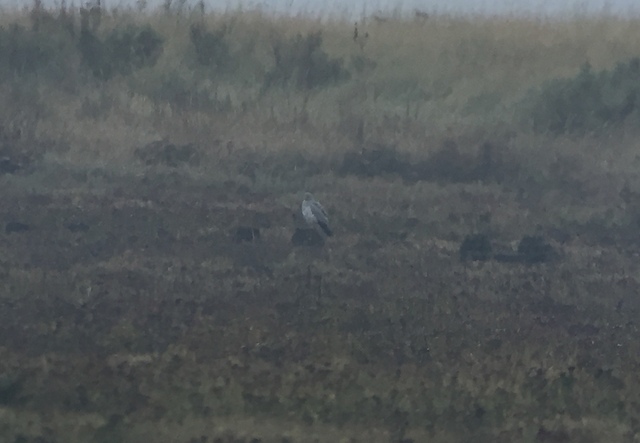 Hen Harrier – a male out on the sat preening out on the saltmarsh
Hen Harrier – a male out on the sat preening out on the saltmarsh
We were still not completely finished. On our way back to Titchwell Manor, we stopped to admire a Barn Owl quartering the fields beside the road. Then it really was time for a well deserved rest.
The following morning, Thursday, we met again and made our way the short distance down the road to the RSPB reserve at Titchwell Marsh. Although the main car park was starting to fill up (even on a damp mid-week November morning!), it was still early enough that the overflow car park was quiet. There were lots of finches feeding in the bushes which were still full of berries – Greenfinches, Chaffinches and Goldfinches. We could hear two Bullfinches calling from opposite sides and a female hopped up into the sallows in front of us before flying off in the direction of the other call. We heard a Brambling call, but it flew off unseen as we rounded the corner.
There were several thrushes here too – Blackbirds, Song Thrushes, and one or two Redwings calling as they flew out of the bushes. A smart Jay flew down to the grassy edge in front of us, where it picked up an acorn and flew off with it. There were no oak trees nearby – perhaps it had stashed it there earlier?
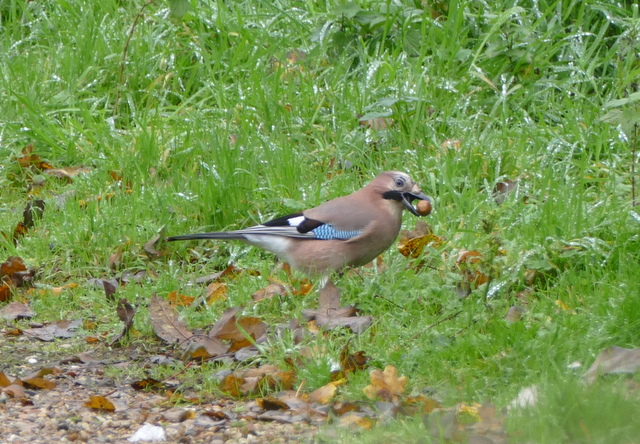 Jay – picked up an acorn from the grass
Jay – picked up an acorn from the grass
We walked out onto the reserve and stopped by the still drained grazing marsh pool. Almost the first bird we saw as we scanned across was a smart Water Pipit. The more we looked, the more we saw – there were at least four Water Pipits out on the mud this morning. We got a good look at them in the scope, noting the neatly black-streaked white underparts and pale supercilium. At one point we even had two Water Pipits and a duller, darker, swarthier Rock Pipit in the same view together – a great comparison of these closely related species.
With only a few puddles, there were not surprisingly few other birds – singles of Redshank, Dunlin and Little Egret. We had heard several Cetti’s Warblers singing as we walked out and one flew across the reeds in front of us, giving the classic glimpse of a Cetti’s Warbler. It was another cloudy morning, but then it started to rain so we made a dash for Island Hide and some shelter.
We had seen lots of Lapwings take off from the reserve and fly off inland as we walked out. Once we got near the hide, we could hear why. The reserve staff were strimming the vegetation along the edge of freshmarsh and all the birds had fled over into the far corner. They were all bunched up together, a huge flock of mainly Teal and Lapwing.
As we started to scan through, we began to pick up some other birds amongst them. There were six Avocets, all asleep at first although we did manage to see them awake later. A few Black-tailed Godwits were feeding up to their bellies in the deeper water, all mostly in grey winter plumage now. A little flock of Dunlin was scampering about on the exposed mud. Among the Lapwing, we managed to find a single Ruff. In with the Teal, there were lots of Gadwall and a few Shoveler. A flock of Brent Geese flew in from the direction of Brancaster and dropped down onto the water to bathe and preen.
Thankfully it didn’t rain for long, and that was to be the only rain we saw this morning. After it stopped, we decided to make our way out towards the beach while the weather was clear. At the Volunteer Marsh, we paused to admire a Greenshank tucked down in a little muddy channel. It was trying to sleep but kept getting buffeted by the wind. It was standing on one leg, but we could see that that one at least was reassuringly the correct colour – green.
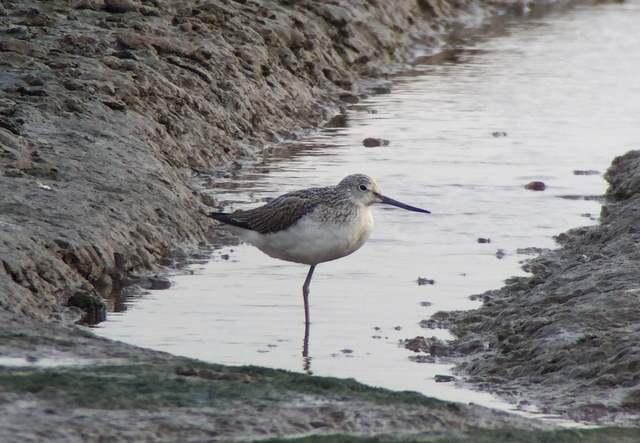 Greenshank – trying to sleep in a muddy channel on the Volunteer Marsh
Greenshank – trying to sleep in a muddy channel on the Volunteer Marsh
A single Black-tailed Godwit was feeding in the channel right beside the path, giving us a great chance to watch it up close. As it bent down to probe its bill deep into the mud it would periodically lower its tail so we could see the black feathers from which it gets its name.
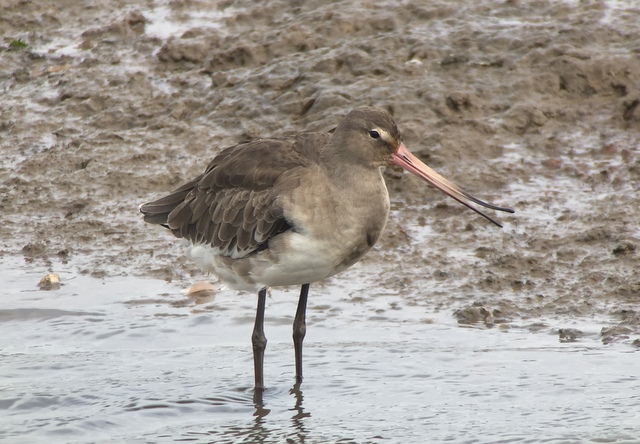 Black-tailed Godwit – showing off how flexible its bill is
Black-tailed Godwit – showing off how flexible its bill is
Scanning across the mud, we could also see lots of Shelduck and a scattering of waders – several Curlew, Grey Plover and Redshank.
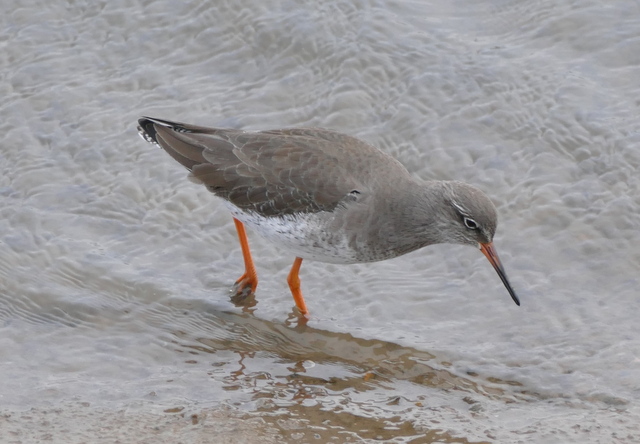 Redshank – note its rather dark grey colouration
Redshank – note its rather dark grey colouration
Out on the Tidal Pools, there were more birds today, with some of them probably sheltering from the disturbance out on the freshmarsh as well as roosting over high tide out on the beach. There were several little groups of Wigeon and Brent Geese feeding on the islands of saltmarsh. In with the Teal out on the water, we picked out five Pintail. Unfortunately there was no sign of a smart drake today, but they are still very elegant ducks.
There were a few waders out on the mud – several more Black-tailed Godwits, Grey Plover, Redshank and Dunlin. Then out in the deeper water we spotted two paler waders, feeding feverishly up to their bellies, jabbing their bills rapidly into the water. We couldn’t see their red legs at first, until one of them came out onto the mud to preen, but they were Spotted Redshanks – much paler than the Common Redshanks, whiter below and silvery grey above, with a longer, needle fine tipped bill.
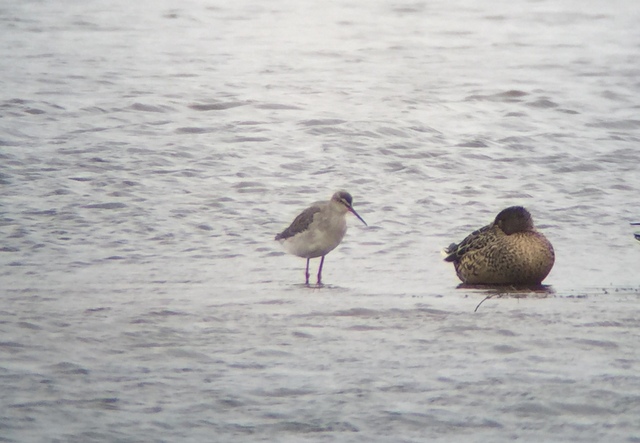 Spotted Redshank – paler than Common Redshank with a longer, finer bill
Spotted Redshank – paler than Common Redshank with a longer, finer bill
Out on the beach, the tide was fast coming in. The rocks were covered but there were still lots of Oystercatchers and Bar-tailed Godwits standing on the water’s edge. Several silvery-white Sanderling were running in and out of the waves and a single Turnstone was patrolling the beach. Pushed up by the rising tide, they eventually had enough and flew off to roost as we stood there. A few Knot flew past as well.
Out on the sea, the first thing we could see was a small group of Red-breasted Mergansers. They were not too far out and correspondingly easy to see, although they were diving constantly. In fact, there were pretty good numbers of Red-breasted Merganser offshore today. Also close in, a single winter-plumaged Red-throated Diver was preening just offshore. Further out, there were several Great Crested Grebes on the water and we picked up a single Long-tailed Duck, though it was hard to make out much detail on it at that range. Small flocks of Common Scoters were flying round but even further out in the haze, towards the Lincolnshire coast! A couple of Gannet flew past.
We wanted to have a look in at Parrinder Hide, so we set off back. We stopped briefly to admire a Little Egret feeding on the Volunteer Marsh on our way. It was using its feet to try to disturb fish from the muddy bottom of the channel – we could see it moving its legs whenever it stood still, staring down into the water.
 Little Egret – fishing on the Volunteer Marsh
Little Egret – fishing on the Volunteer Marsh
The warden had stopped strimming now and the birds had started to spread back out over the whole of the freshmarsh. There were a few more waders in, including several bright-spangled Golden Plover, but nothing else that we hadn’t seen more distantly earlier. However, the highlight was a very smart Common Snipe which walked along the water’s edge and started feeding just below the front of the hide, giving us stunning close-up views. When it wasn’t moving it was remarkably well camouflaged in among the dried out cut rushes and reeds.
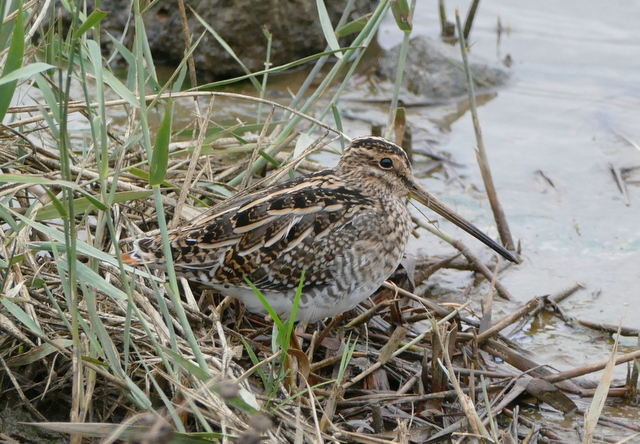 Common Snipe – feeding right in front of Parrinder Hide
Common Snipe – feeding right in front of Parrinder Hide
We walked back round via Meadow Trail and out towards Patsy’s Reedbed, stopping on the way to watch a flock of Long-tailed Tits which came through the trees above our heads. There were fewer ducks on Patsy’s than in recent weeks, though three Tufted Ducks provided a welcome addition to the trip list. A couple more Snipe were feeding along the shore and lots of Black-tailed Godwit and Lapwing were mostly sleeping on the islands.
Then it was time for us to head back for a late lunch at Titchwell Manor before the tour concluded. Despite the weather being at times inclement it had been a remarkably successful couple of days with an excellent list of species seen, including a couple of more unusual visitors, late migrants and a selection of our regular wintering birds. Great birding.
















